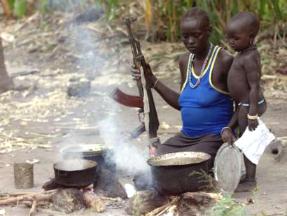After six years, scars of war still visible in southern Sudan town

By Bogonko Bosire
RUMBEK, South Sudan, Oct 2 (AFP) — Six years after rebels captured Rumbek, the battle scars are still visible in this strategic town, which now serves as a humanitarian coordination centre for war-ravaged southern Sudan.
Buildings in Rumbek, which was recaptured by the rebel Sudan People’s Liberation Army (SPLA) from government forces in 1997, bare bullet marks while others have gaping holes on the walls or stand half-demolished by mortar shells.
Burned out tanks and amoured personnel carriers litter the town’s dirt roads.
A wrecked Land Rover lay overgrown with vegetation near the UN children’s fund (UNICEF) compound and around the ruins of the vehicle were scattered ammunition casings, wooden boxes and fuel containers.
The local population looted military equipment left behind by fleeing government troops, while SPLA fighters grabbed guns and ammunition, according to a resident.
“This vehicle was taken out by a rapid succession of shells,” said an SPLA soldier, who asked not to be named.
Visibly upset, the soldier pointed in the direction of Rumbek Girls High School: “That is where my colleagues were caught by a mortar shell and killed, ” he said.
Sudan’s civil war erupted in 1983 when the SPLA took up arms to end domination of the mainly Christian and animist south by the Muslim north. It has since killed more than 1.5 million people and displaced four million others.
But the battle for Rumbek lasted a mere 18 hours one day in May 1997.
Now teenage boys roam the dusty paths armed with assault rifles, despite an SPLA decision several years ago to demobilise child soldiers.
“Most of them have nothing to do now and pose a threat to society,” John Riek, a captain the SPLA told AFP.
Riek, who joined the southern rebel movement in 1984 after finishing primary school, said the “ghosts of war still haunt people here in Rumbek.”
Since 1983, the battle to control over resources, including oil, has played an increasingly important role in the conflict.
At a former Sudanese army garrison, five kilometres (three miles) from Rumbek, rusty anti-aircraft guns still stood near an airstrip, the paint peeling off and covered with a blue plastic bag.
Children played hide-and-seek in the ruins of the garrison, apparently oblivious to the fact that several government troops were killed as they fled from the area while others were taken prisoner.
Four children, only one of them dressed, played in the bunkers, most of them overgrown with vegetation.
A rusty machinegun mounted on a metal tripod lay in the centre of a homestead facing the airstrip. Just under it were two boxes full of bullets.
“We never trust anybody in this corner of the world. That is why I am guarding the airport,” said a barefoot gunner, binoculars hanging from his shoulder.
A UN official said landmines are scattered around Rumbek.
Both the governmenmt and the SPLA on September 24 reached an agreement in the Kenyan town of Naivasha under which they will establish security arrangements, including integrating some of their forces.
Under an agreement reached last year, Khartoum and the rebels decided on a six-year transitional period at the end of which the southern Sudanese would vote for unity or secession.
Talks will continue on the last sticking points of power-sharing and oil resources, as well as disputed regions.
